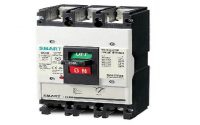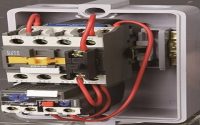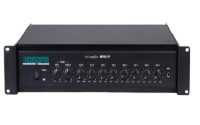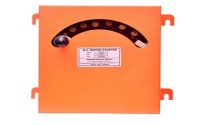Types of Losses in a Transformer and Their Efficiency
An ideal transformer is very efficient so they don’t have energy losses, which means the power supplied to the transformer’s input terminal must be equivalent to the power supplied to the transformer’s output terminal. So the input power and output power in an ideal transformer are equal including zero energy losses. But in practice, both the input and output powers of the transformer will not equal due to electrical losses within the transformer. It is a static device because it doesn’t have any movable parts, so we cannot observe mechanical losses but electrical losses will occur like copper and iron. This article discusses an overview of different types of losses in a transformer.
Types of Losses in a Transformer
There are different kinds of losses that will be occurred in the transformer such as iron, copper, hysteresis, eddy, stray & dielectric. The copper loss mainly occurs due to the resistance in the transformer winding whereas hysteresis losses will be occurred due to the magnetization change within the core.
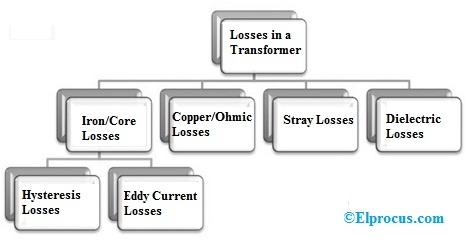
Iron Losses in a Transformer
Iron losses mainly occur through the alternating flux within the transformer’s core. Once this loss occurs within the core then it is called core loss. This kind of loss mainly depends on the material’s magnetic properties within the core of the transformer. The core in the transformer can be made with iron, so these are called iron losses. This type of loss can be categorized into two types like hysteresis as well as eddy current.
Hysteresis Loss
This kind of loss mainly occurs when the alternating current is applied to the core of the transformer then the magnetic field will be reversed. This loss mainly depends on the core material used in the transformer. To reduce this loss, the high-grade core material can be used. CRGO- Cold rolled grain oriented Si steel can be used commonly like the core of the transformer so that Hysteresis loss can be reduced. This loss can be represented by using the following equation.
Ph = Khf Bx m
Where
‘kh’ is the constant that depends on the quality & volume of the core material in the transformer
‘Bm’ is the highest flux density within the core
‘f’ is the alternating flux frequency otherwise supply
‘x’ is the constant of the Steinmetz and the value of this constant mainly changes from 1.5 to 2.5.
Eddy Current Loss
Once the flux is connected to a closed circuit, then an e.m.f can be induced within the circuit and there is a supply in the circuit. The flow of current value mainly depends on the sum of an e.m.f and resistance in the region of the circuit.
The core of the transformer can be designed with a conducting material. The flow of current in the emf can be supplied within the body of the material. This flow of current is known as eddy current. This current will occur once the conductor experiences an altering magnetic field.
When these currents are not accountable for doing any functional task, then it generates a loss within the magnetic material. So it is called as an Eddy Current Loss. This loss can be reduced by designing the core using slight laminations. The eddy current equation can be derived by using the following equation.
Pe = KeBm2t2f2V watts
Where,
‘Ke’ is the co-efficient of eddy current. This value mainly depends on the magnetic material’s nature like resistivity and volume of the core material & the width of laminations
‘Bm’ is the highest rate of flux density in wb/m2
‘T’ is the width of lamination within meters
‘F’ is the frequency of reverse of the magnetic field measured in Hz
‘V ‘is the amount of magnetic material in m3
Copper Loss
Copper losses occur because of the Ohmic resistance in the windings of the transformer. If the primary and secondary windings of the transformer are I1 and I2, then the resistance of these windings is R1 & R2. So the copper losses that occurred in the windings are I12R1 & I22R2 respectively. So, the entire copper loss will be
Pc = I12R1 + I22R2
These losses also called variable or ohmic losses because these losses will change based on the load.
Stray Loss
These types of losses in a transformer can be occurred because of the occurrence of the leakage field. As compared with copper and iron losses, the percentage of stray losses are less, so these losses can be neglected.
Dielectric Loss
This loss mainly occurs within the oil of the transformer. Here oil is an insulating material. Once the oil in the transformer gets deteriorates otherwise when oil quality diminishes then the transformer’s efficiency will be affected.
Efficiency of Transformer
The definition of efficiency is similar to an electrical machine. It is the ratio of output power and input power. The efficiency can be calculated by the following formula.
Efficiency = Output Power / Input Power.
The transformer is a highly efficient device and the load efficiency of these devices mainly ranges between 95% – 98.5%. When a transformer is highly efficient, then its input and output have almost the same value, and therefore it is not practical to calculate the efficiency of the transformer by using the above formula. But to find its efficiency, the following formula is better to use
Efficiency = (Input – Losses) / Input => 1 – (Losses /Iinput).
Let copper loss is I2R1 whereas iron loss is Wi
Efficiency = 1-Losses/Input
= 1-I12R1+Wi/V1I1CosΦ1
Ƞ = 1-(I1R1/V1CosΦ1) –Wi/ V1I1CosΦ1
Differentiate the above equation with respect to ‘I1’
d Ƞ/dI1= 0- (R1/V1CosΦ1) + Wi/V1I12 CosΦ1
‘Ƞ’ is maximum at d Ƞ/dI1 =0
Therefore, efficiency ‘Ƞ’ will be maximum at
R1/V1CosΦ1 = Wi/V1I12 CosΦ1
I12R1/ V1I12 CosΦ1 = Wi/V1I12 CosΦ1
I12R1 = Wi
Therefore, the transformer efficiency can be highest when iron and copper losses are equal.
So, Copper loss = Iron loss.
Thus, this is all about an overview of the types of losses in a transformer. In a transformer, energy loss can be occurred due to several reasons. So the transformer efficiency will be reduced. The main reasons for different types of losses in a transformer are due to the effect of heat in the coil, magnetic flux leakage, magnetization & demagnetization of the core. Here is a question for you, what are the different types of transformers available in the market?

